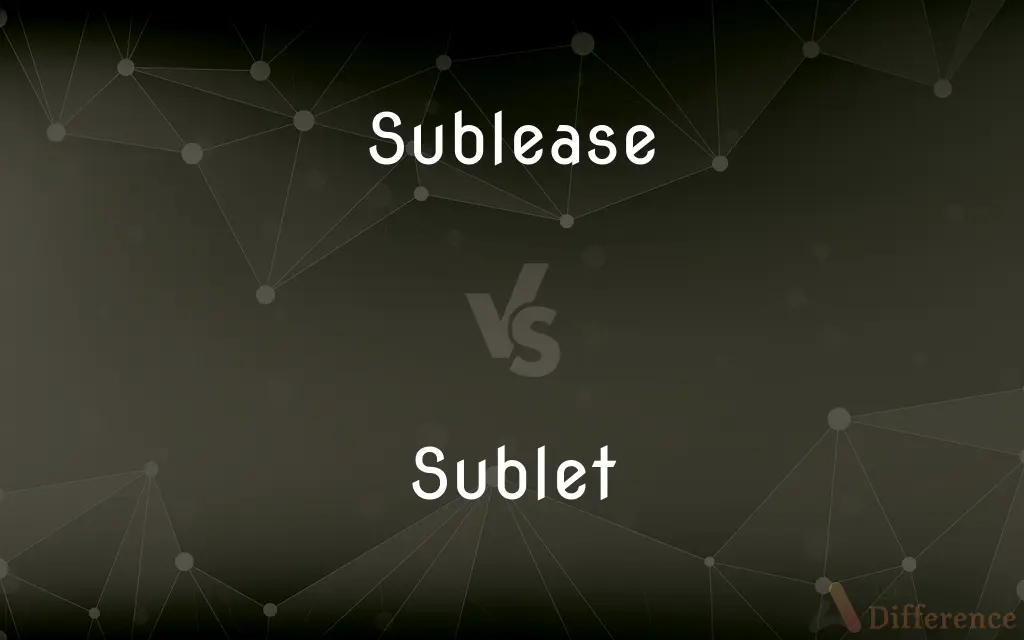Sublease vs. Sublet — What's the Difference?
By Tayyaba Rehman & Urooj Arif — Updated on April 26, 2024
Subleasing involves a tenant re-renting a property to another, while subletting generally refers to the act itself of renting this property.

Difference Between Sublease and Sublet
Table of Contents
ADVERTISEMENT
Key Differences
Subleasing is a legal arrangement where the original tenant rents out the leased premises to a new tenant, retaining some rights over the property. Whereas, subletting specifically refers to the action of renting out the property, focusing more on the process rather than the contractual relationship.
In subleasing, the sublessee typically enters into a rental agreement with the original tenant, not the property owner. On the other hand, subletting doesn't necessarily imply a new formal agreement, as it can be informal or temporary depending on the circumstances.
Subleases often require the consent of the landlord before they can be executed, ensuring that the sublessee is acceptable to the landlord. Whereas, subletting arrangements might not always require direct landlord approval, especially in casual or short-term scenarios.
A sublease can establish a new legal relationship between the original tenant (as a sublessor) and the new tenant (as a sublessee). In contrast, subletting might simply involve the original tenant allowing someone else to use the space temporarily without establishing a formal sublessor-sublessee relationship.
Financially, subleasing can affect the original tenant's rental liability, as they remain responsible for the rent to the landlord and must collect rent from the sublessee. Conversely, subletting may involve less formal financial arrangements, with the subtenant possibly paying rent directly to the original tenant without a structured schedule.
ADVERTISEMENT
Comparison Chart
Definition
A lease by a tenant to a third party
The act of leasing a property by a tenant
Legal Relationship
Creates a new tenant-landlord relationship
Typically informal, without new legal ties
Duration
Often long-term or for the remainder of a lease
Can be short-term or as agreed upon
Formality
Requires formal agreement and often landlord approval
May not require landlord approval or formal agreements
Financial Responsibility
Original tenant remains responsible to landlord
Financial terms more flexible and negotiable
Compare with Definitions
Sublease
A transfer of lease rights from the original tenant to a new tenant.
John signed a sublease to rent his apartment to Jane for six months.
Sublet
Can be informal or based on a verbal agreement.
Bob sublet his apartment to a friend for three weeks.
Sublease
Often entails landlord approval before execution.
Mike obtained his landlord's consent to sublease his studio.
Sublet
Less likely to require landlord approval.
Emily sublet her flat without needing to notify her landlord.
Sublease
Maintains the original tenant's responsibility for the lease.
Despite subleasing, Tom is still liable for the apartment's condition.
Sublet
May not involve modifying the original lease.
Dave's sublet did not change his original rental agreement.
Sublease
Typically used for transferring the majority or all of a property's use.
Linda subleased her entire condo while she traveled abroad.
Sublet
Often used for temporary arrangements.
Carol sublet her beach house for a weekend.
Sublease
A lease of a property by a tenant to a subtenant; a sublet.
Sublet
The act of renting out a rented property to another individual.
Anna decided to sublet her rented room over the summer.
Sublease
Another term for sublet
Sublet
Lease (a property) to a subtenant
I quit my job and sublet my apartment
Sublease
To sublet (property).
Sublet
A lease of a property by a tenant to a subtenant.
Sublease
To rent (property) under a sublease.
Sublet
To rent (property) from one who is a lessee rather than the owner.
Sublease
A lease of property granted by a lessee.
Sublet
To rent (property one holds by lease) to another.
Sublease
(property law) A lease sublet by a tenant or lessee to a subtenant.
Sublet
To subcontract (work).
Sublease
Synonym of sublet.
Sublet
To rent property from one who is a lessee rather than the owner.
Sublease
A lease by a tenant or lessee to another person; an underlease.
Sublet
To rent property one holds by lease to another.
Sublease
A lease from one lessee to another
Sublet
To be available for rent by a tenant to another party
This apartment sublets for $1,500 a month.
Sublease
Lease or rent all or part of (a leased or rented property) to another person;
We sublet our apartment over the summer
Sublet
Property, especially an apartment, rented by a tenant to another party.
Sublease
A legal agreement creating a tenant and subtenant relationship.
Sarah entered a sublease that makes her responsible for rent collection.
Sublet
To grant a sublease out of property held under a lease.
Sublet
Synonym of sublease.
Sublet
To underlet; to lease, as when a lessee leases to another person.
Sublet
A lease from one lessee to another
Sublet
Lease or rent all or part of (a leased or rented property) to another person;
We sublet our apartment over the summer
Common Curiosities
Are subleases more formal than sublets?
Yes, subleases are more formal, typically requiring written agreements and landlord approval.
Can subletting be done without a contract?
Yes, subletting can be done informally, sometimes even without a written contract.
What does sublet mean?
Subletting refers to the act of a tenant renting out their space to another person, often temporarily.
Who is responsible for the rent in a sublease?
The original tenant remains responsible for the rent in a sublease scenario.
How does subleasing affect the original lease?
Subleasing does not terminate the original lease; it adds a new layer of tenancy.
Are sublease and sublet subject to the same legal regulations?
Yes, both sublease and sublet arrangements are typically governed by landlord-tenant laws and regulations specific to the jurisdiction.
What is subleasing?
Subleasing is when a tenant rents out their leased property to a new tenant under a new agreement.
Are sublease and sublet common in rental agreements?
Yes, they provide flexibility for tenants who need to move temporarily or share space while maintaining the primary lease agreement.
Is landlord approval required for subletting?
Landlord approval is not always required for subletting, though it depends on the original lease terms.
Can tenants profit from subleasing or subletting?
Yes, tenants may charge a higher rent to sublessees or subtenants, potentially covering their own rental costs and even making a profit.
Share Your Discovery

Previous Comparison
Hunk vs. Stud
Next Comparison
Academia vs. AcademeAuthor Spotlight
Written by
Tayyaba RehmanTayyaba Rehman is a distinguished writer, currently serving as a primary contributor to askdifference.com. As a researcher in semantics and etymology, Tayyaba's passion for the complexity of languages and their distinctions has found a perfect home on the platform. Tayyaba delves into the intricacies of language, distinguishing between commonly confused words and phrases, thereby providing clarity for readers worldwide.
Co-written by
Urooj ArifUrooj is a skilled content writer at Ask Difference, known for her exceptional ability to simplify complex topics into engaging and informative content. With a passion for research and a flair for clear, concise writing, she consistently delivers articles that resonate with our diverse audience.
















































